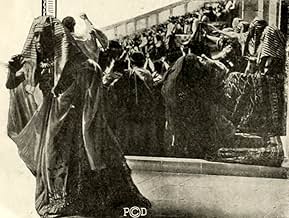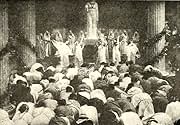IMDb-BEWERTUNG
6,1/10
652
IHRE BEWERTUNG
Füge eine Handlung in deiner Sprache hinzuTwo love triangles intersect in ancient Pompei.Two love triangles intersect in ancient Pompei.Two love triangles intersect in ancient Pompei.
- Regie
- Drehbuch
- Hauptbesetzung
Empfohlene Bewertungen
This amazing Italian silent epic, featuring a cast of millions, will blow your mind as thoroughly as Mt. Vesuvius blew up Pompeii. Breathtaking special effects, an excitingly melodramatic plot, stunning settings, and gorgeous cinematography combine to make this one of the first great feature films.
The cinematography is very different to what we are used to today - the camera does not move at all - but the shots are so well lit that it hardly seems to matter. And the genuine beauty of the final shot makes the scene very moving indeed.
This is an unmissable masterpiece of cinema.
The cinematography is very different to what we are used to today - the camera does not move at all - but the shots are so well lit that it hardly seems to matter. And the genuine beauty of the final shot makes the scene very moving indeed.
This is an unmissable masterpiece of cinema.
The eruption of Vesuvius plays only a minor part in this lurid tale of murder, blackmail, insanity, witches, unrequited love, gladiators, imprisonment and blindness. However, as this was made in 1913, it's all done in the best possible taste, and The Last Days of Pompeii is one of the figureheads of early Italian cinema as it's an epic feature-length movie from a time when other countries were still making small-scale 20-minute shorts. Hugely influential, then - Griffith, whose own feature-length epic was still two years off was a fan - but kind of camp.
This silent Italian melodrama may be a challenge for modern viewers, but it's a "must" for real fans of the silent era. Along with other early Italian epics now available in great DVD editions, such as "Cabiria" from 1914, these movies remind Americans that before World War I, European filmmakers were creative pioneers who stretched the medium and the imaginations of American directors. This film version of the "Pompeii" story was shot with static cameras and looks a bit like a broadly acted stage production transfered to film. But the production is elaborate, featuring stage sets as well as some location shooting. Just watching the images unfold in this twisted tale of love and jealousy on the eve of the disastrous eruption of Mt. Vesuvius can be fascinating as we peer back across the century at this 1913 release. To current sensibilities, the film does reflect some prejudices of its era, including the casting of an Egyptian priest as the mysterious, evil force in Pompeii -- an early example of a century-long demonization of Arab figures in movies. However, for viewers exploring early cinema, who are familiar mainly with slapstick comedies and D.W. Griffith, watching a pre-WWI Italian epic like this can be a fascinating experience.
I am so sorry to say, even though this film adaption of "Last Days of Pompeii" (Gli Ultimi Giorni di Pompeii) is suppose to be very serious, but as I watched it back in my old High School history class, I just could not help but break out into fits of laughter.
Is it me, or does most of the people who acted in this film look like they had their overdosage of sugar and caffeine? Yeah, I wonder that too, because everyone, and I mean EVERYONE in this film looks like they are way too hyperactive to be in this film. But hey, at least it was a SILENT film, right folk? Right. There is even a few scenes in the film where the actress who played Nydia was trying to hold back her laughter.
If you see this film in a history class, or if you plan to rent the film, be prepaired to hold back laughing at something that is suppose to be serious.
WARNING: Do not watch this film after having intense facial surgery or an operation on your body.
Is it me, or does most of the people who acted in this film look like they had their overdosage of sugar and caffeine? Yeah, I wonder that too, because everyone, and I mean EVERYONE in this film looks like they are way too hyperactive to be in this film. But hey, at least it was a SILENT film, right folk? Right. There is even a few scenes in the film where the actress who played Nydia was trying to hold back her laughter.
If you see this film in a history class, or if you plan to rent the film, be prepaired to hold back laughing at something that is suppose to be serious.
WARNING: Do not watch this film after having intense facial surgery or an operation on your body.
Despite its old-fashioned format and performances, this early full-length feature is still of some interest, at least historically, and it is probably a little better as a movie than many give it credit for. It was quite an ambitious attempt to tell a relatively involved story with some large-scale settings and a few special visual effects.
It follows a formula that may be even more popular now than it was in the 1910's: take a tumultuous historical event, introduce a set of fictional characters, and show what was going on in their lives when the event took place. In this respect, "The Last Days of Pompeii" may to some degree have established the formula that is still being used for films such as "Titanic", "Pearl Harbor" and many others. If you adjust for the limitations of its era, "The Last Days of Pompeii" is at least as good as those films, as well as many others of the genre.
The story, though sometimes too melodramatic and implausible, is interesting enough most of the time, and while the settings aren't going to impress anyone now, they do display a fair amount of creative effort. None of the cast give particularly strong performances, but their acting styles are not inherently any worse than the acting styles of the present. Some of the present day's most popular performers use affected, artificial styles that are trendy now, but that won't look any better in 90 years than the histrionics of this Italian cast look today.
There's no denying the weaknesses, many of which come from the tableau format and/or from inexperience with telling a full-length story on the silent screen. There are some stretches, especially in the first half, which move very slowly. Some of the characters, especially Nidia, could have been much more compelling with more creative filming and acting.
Within just a few years, the stereotyped tableau format would be largely abandoned, better ways of telling a story would be developed, and better ways of integrating the camera and the performers would be devised. While that might not make this film any better in itself, it was the first few ambitious attempts like "The Last Days of Pompeii" that helped lead to such improvements. While it's only an average film in itself, it deserves also to be remembered as a pioneering effort.
It follows a formula that may be even more popular now than it was in the 1910's: take a tumultuous historical event, introduce a set of fictional characters, and show what was going on in their lives when the event took place. In this respect, "The Last Days of Pompeii" may to some degree have established the formula that is still being used for films such as "Titanic", "Pearl Harbor" and many others. If you adjust for the limitations of its era, "The Last Days of Pompeii" is at least as good as those films, as well as many others of the genre.
The story, though sometimes too melodramatic and implausible, is interesting enough most of the time, and while the settings aren't going to impress anyone now, they do display a fair amount of creative effort. None of the cast give particularly strong performances, but their acting styles are not inherently any worse than the acting styles of the present. Some of the present day's most popular performers use affected, artificial styles that are trendy now, but that won't look any better in 90 years than the histrionics of this Italian cast look today.
There's no denying the weaknesses, many of which come from the tableau format and/or from inexperience with telling a full-length story on the silent screen. There are some stretches, especially in the first half, which move very slowly. Some of the characters, especially Nidia, could have been much more compelling with more creative filming and acting.
Within just a few years, the stereotyped tableau format would be largely abandoned, better ways of telling a story would be developed, and better ways of integrating the camera and the performers would be devised. While that might not make this film any better in itself, it was the first few ambitious attempts like "The Last Days of Pompeii" that helped lead to such improvements. While it's only an average film in itself, it deserves also to be remembered as a pioneering effort.
Wusstest du schon
- WissenswertesFor a while in the late summer and fall of 1913 there were two major Italian productions on this subject playing simultaneously in the US, this one produced by Ambrosio, and Jone ovvero gli ultimi giorni di Pompei (1913), produced by Pasquali.
- PatzerExtras are "killed" by falling pieces of a set during the explosion scene, then appear to either get back up or adjust themselves so that they won't be trampled by other extras.
- Alternative VersionenKino International Corp. copyrighted a version in 2000 with a piano music score compiled and arranged by Beatrice Jona Affron and performed by Martha Koeneman. It was produced for video by Bret Wood and runs 88 minutes.
- VerbindungenFeatured in Kino Europa - Die Kunst der bewegten Bilder: Where It All Began (1995)
- SoundtracksGiselle
Written by Adolphe Adam (as Adam)
Arranged by Beatrice Jona Affron
Performed by Martha Koeneman
Excerpts in the 2000 alternate version score
Top-Auswahl
Melde dich zum Bewerten an und greife auf die Watchlist für personalisierte Empfehlungen zu.
Details
- Erscheinungsdatum
- Herkunftsland
- Sprachen
- Auch bekannt als
- The Last Days of Pompeii
- Produktionsfirma
- Weitere beteiligte Unternehmen bei IMDbPro anzeigen
- Laufzeit1 Stunde 28 Minuten
- Farbe
- Sound-Mix
- Seitenverhältnis
- 1.33 : 1
Zu dieser Seite beitragen
Bearbeitung vorschlagen oder fehlenden Inhalt hinzufügen

Oberste Lücke
By what name was Die letzten Tage von Pompeji (1913) officially released in Canada in English?
Antwort





















